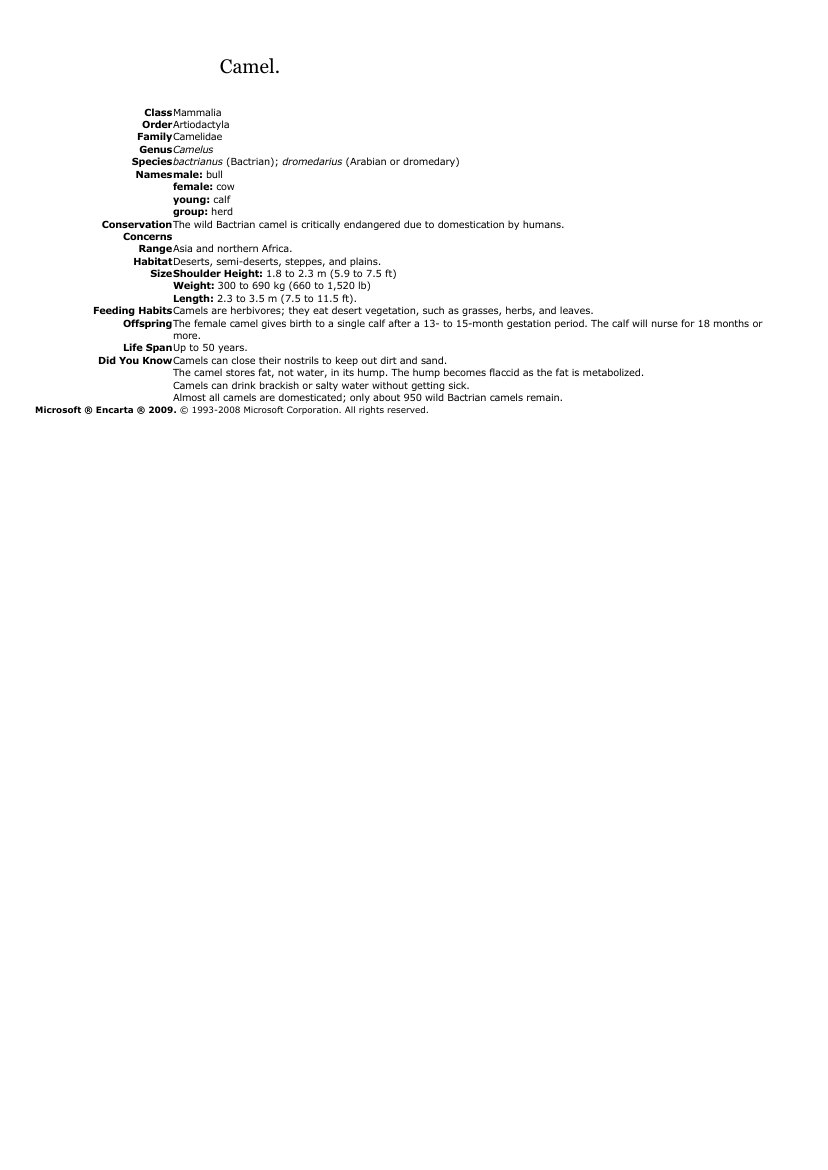Camel.
Publié le 06/12/2021

Extrait du document
Ci-dessous un extrait traitant le sujet : Camel.. Ce document contient 179 mots. Pour le télécharger en entier, envoyez-nous un de vos documents grâce à notre système d’échange gratuit de ressources numériques ou achetez-le pour la modique somme d’un euro symbolique. Cette aide totalement rédigée en format pdf sera utile aux lycéens ou étudiants ayant un devoir à réaliser ou une leçon à approfondir en : Echange
Camel.
Class Mammalia
Order Artiodactyla
Family Camelidae
Genus Camelus
Species bactrianus (Bactrian); dromedarius (Arabian or dromedary)
Names male: bull
female: cow
young: calf
group: herd
Conservation The wild Bactrian camel is critically endangered due to domestication by humans.
Concerns
Range Asia and northern Africa.
Habitat Deserts, semi-deserts, steppes, and plains.
Size Shoulder Height: 1.8 to 2.3 m (5.9 to 7.5 ft)
Weight: 300 to 690 kg (660 to 1,520 lb)
Length: 2.3 to 3.5 m (7.5 to 11.5 ft).
Feeding Habits Camels are herbivores; they eat desert vegetation, such as grasses, herbs, and leaves.
Offspring The female camel gives birth to a single calf after a 13- to 15-month gestation period. The calf will nurse for 18 months or
more.
Life Span Up to 50 years.
Did You Know Camels can close their nostrils to keep out dirt and sand.
The camel stores fat, not water, in its hump. The hump becomes flaccid as the fat is metabolized.
Camels can drink brackish or salty water without getting sick.
Almost all camels are domesticated; only about 950 wild Bactrian camels remain.
Microsoft ® Encarta ® 2009. © 1993-2008 Microsoft Corporation. All rights reserved.
Camel.
Class Mammalia
Order Artiodactyla
Family Camelidae
Genus Camelus
Species bactrianus (Bactrian); dromedarius (Arabian or dromedary)
Names male: bull
female: cow
young: calf
group: herd
Conservation The wild Bactrian camel is critically endangered due to domestication by humans.
Concerns
Range Asia and northern Africa.
Habitat Deserts, semi-deserts, steppes, and plains.
Size Shoulder Height: 1.8 to 2.3 m (5.9 to 7.5 ft)
Weight: 300 to 690 kg (660 to 1,520 lb)
Length: 2.3 to 3.5 m (7.5 to 11.5 ft).
Feeding Habits Camels are herbivores; they eat desert vegetation, such as grasses, herbs, and leaves.
Offspring The female camel gives birth to a single calf after a 13- to 15-month gestation period. The calf will nurse for 18 months or
more.
Life Span Up to 50 years.
Did You Know Camels can close their nostrils to keep out dirt and sand.
The camel stores fat, not water, in its hump. The hump becomes flaccid as the fat is metabolized.
Camels can drink brackish or salty water without getting sick.
Almost all camels are domesticated; only about 950 wild Bactrian camels remain.
Microsoft ® Encarta ® 2009. © 1993-2008 Microsoft Corporation. All rights reserved.
↓↓↓ APERÇU DU DOCUMENT ↓↓↓


